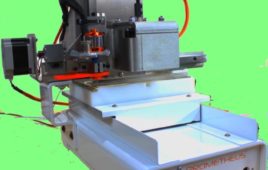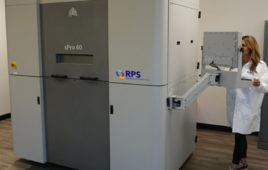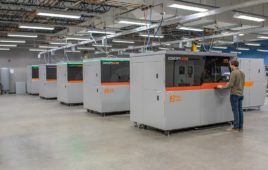Introduction
When determining how to transfer liquid waste within an analyzer, design engineers must examine many factors. Though several methods will work, only one provides optimized system performance and lifetime.
Clinical diagnostic and laboratory applications encompass a wide spectrum of processes, including probe washing, sample well or couvette emptying and washing, slide staining, rinsing, reagent washing, and general draining. Many of these processes generate liquids that must be pumped to waste. These liquids range from simple DI water to bleach concentrations, to remainders from tests that include sticky proteins, magnetic beads and particles, and chemical reaction leftovers. Additionally, molecular diagnostics involves cell lysing and amplification, processes that can include elevated temperatures and aggressive chemicals. All of these differing processes and media add complexity to pump selection decisions. System design engineers are encouraged to talk with KNF Applications Engineers to be certain the best pump is selected for the intended function.
There are two main methods for removing liquid waste from an analyzer: Direct Handling, and Waste Collection followed by Evacuation.
Method 1 – Direct Handling of Liquid Waste
Liquid pumps can directly handle waste fluids, and either transfer them to a collection tank or pump them straight to waste/drain. (see flow diagram below) The advantages to this de-centralized approach are: simplicity of pump control, small pump size, lower pump cost, and possibly fewer system components. Additionally, the system is more easily re-configured if flow requirements change. Frequently, the same pump model specified for the probe wash function is also used here for a better economy of scale, although high-pressure pumps may be the best choice for the washing function.
A designer should be aware that the pump will be pressurizing liquid that will probably contain biological waste, so extra caution should be exercised to prevent clogging or leakage. Lines should be smooth, as short as possible, and of the widest diameter possible. Pressure limiting devices should be considered (KNF can include these in the pump head or as a separate component). Pumps are more prone to clogging if shards of glass or other large debris are present in the fluid.
Filtering upstream from the pump may be necessary to assure no particles are present (typically >100 microns). As the media is a combination of liquid and air, the designer may be tempted to consider a gas-handling model. This should usually be avoided because the incompressible properties of liquids require a pump designed specifically for liquid service. The direct handling of liquid waste method requires proper sizing of the pump(s) and timing of valves to ensure highest-case flow rates can be handled. One advantage to this method is increased tolerance to system modifications.
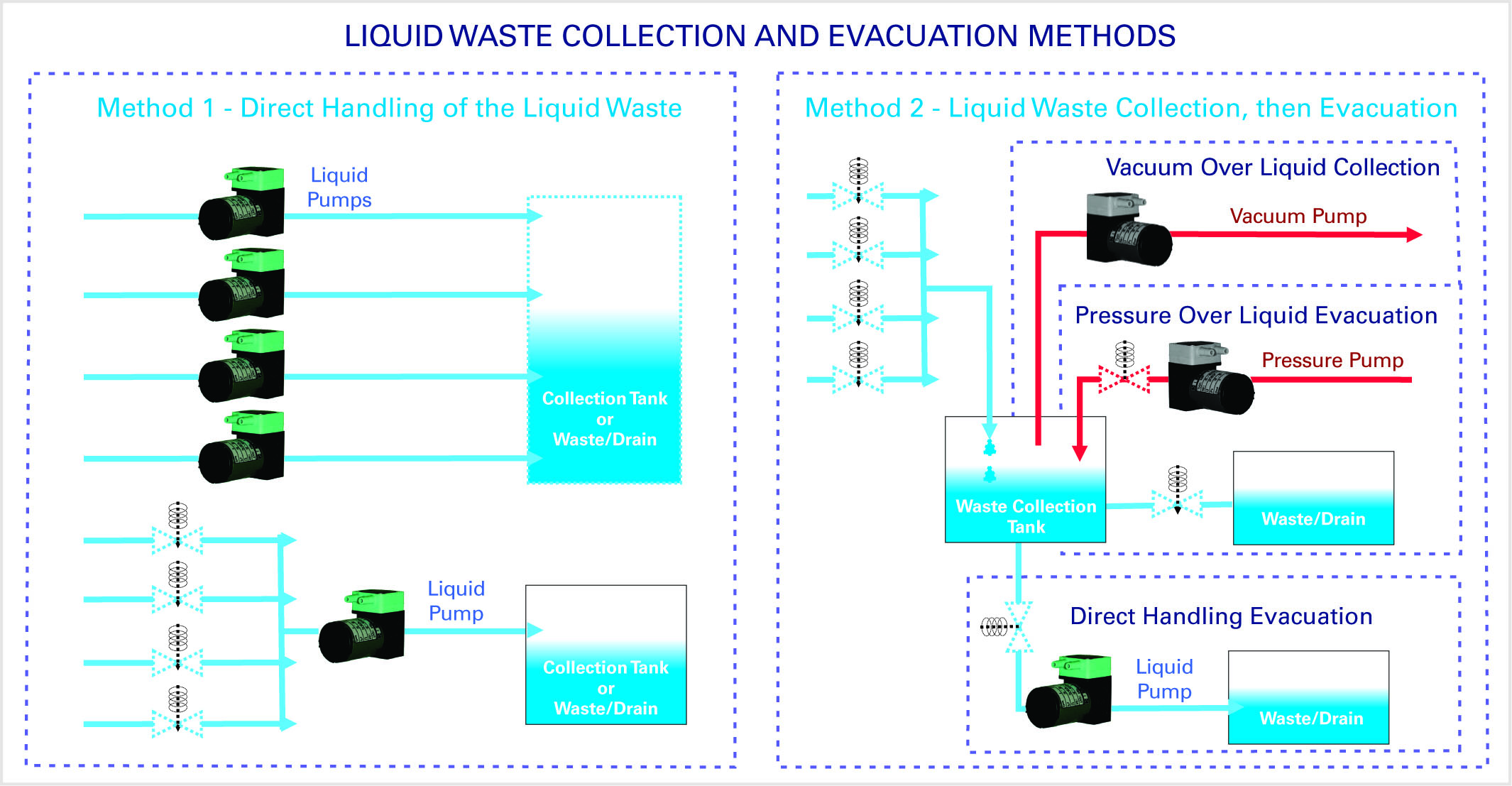
(Credit: KNF)
Method 2 – Waste Collection, then Evacuation
Vacuum Over Liquid Collection – Another popular method involves a centralized diaphragm pump (normally gas) that develops and maintains a vacuum in a sealed reservoir, which is connected via solenoid valves or a manifold to the various liquid lines.
Thanks to recent advances in diaphragm pump technology, this pump type is preferred over traditional reciprocating piston, scroll, or rotary pumps. Diaphragm pumps have earned this distinction owing to their ability to handle the inevitable humid vapors and even liquids on occasion. Other pump types may be damaged from this mixed media, however a diaphragm pump can handle it easily – usually requiring just a simple air purge to resume normal operation if a gas pump is selected, and probably no purge at all if a liquid pump is used.
Liquid pumps are usually the pumps of choice if the mixed media flow rates are small (< 5 L/min combined liquid and gas) while gas pumps are favored for higher flow rates up to 150 L/min or more. Vacuum may be maintained in the tank via speed-controlling the pump to optimize system noise and lifetime, or the pump may be cycled on and off as required. One benefit of the vacuum over liquid method is it allows flexibility in dealing with varying amounts of generated waste. A relatively small pump may handle multiple lines if the vacuum needs can be timed properly.
Tank Evacuation, Direct Handling – Once the waste collection tank is full—as determined by a sensor or on a quasi-continuous basis for tank size reduction—it must be evacuated to waste/drain. Again, diaphragm liquid pumps excel in this application. Direct handling with a diaphragm pump is probably the most popular way to evacuate the liquid waste since these pumps are able to withstand the myriad of accumulated chemicals. In order to generate flow in the proper direction, the pump used in this application must develop a vacuum deeper than the gas vacuum pump used for vacuum over liquid collection (typically up to 27 “Hg). A liquid pump is required for this function, and it may even be the same pump used to move the liquid to waste in either of the applications described above. The advantage to this type of pumping solution is that the instrument is able to continue processing fluids during the evacuation process, thus increasing sample throughput. The diaphragm pump’s vacuum generating ability remains stable over time, unlike that of a peristaltic, piston, gear, or rotary. It should also be more reliable and consistent than house vacuum, especially if the vacuum is consumed on a continuous basis.
Tank Evacuation, Pressure over Liquid – An alternative to direct handling, this solution has the advantage that the pump is not in contact with the collected waste and debris. However pressure over liquid is still less popular because of two possible problems: (1) clogging downstream of the tank may allow medical waste to escape outside the containment area, and (2) the vacuum in the tank must be broken, leading to reduced throughput.
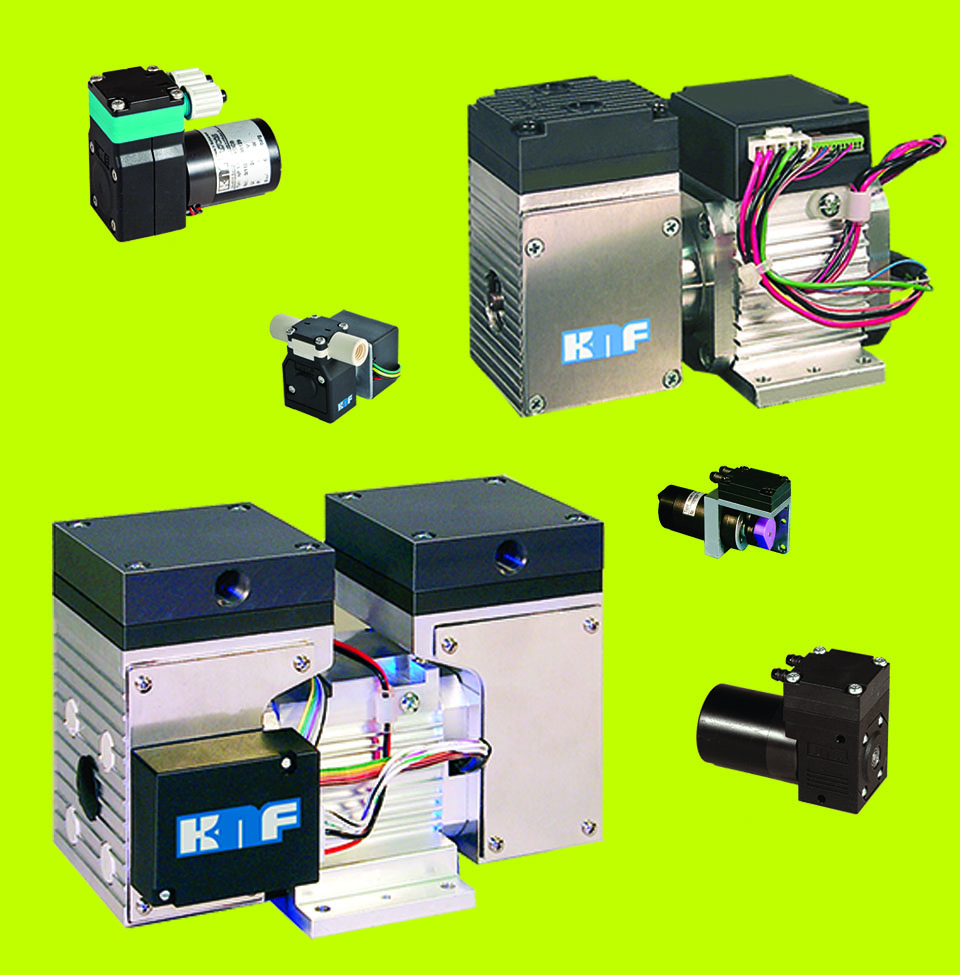
(Credit: KNF)
KNF Diaphragm Pumps for Liquid Waste Handling
· Many wetted materials from which to choose
· Many motor options, including long-life, brushless DC with logic speed-control
· Liquid flow rates to 6 L/min
· Self-priming liquid pumps
· Air/Gas flow rates to >150 L/min
· Custom OEM projects encouraged
Conclusion
There are many solutions to handling liquid waste and a wide selection of pumps that can aid in this process. It is important to correctly identify the best method of removing liquid waste to strike an acceptable balance between function, maintenance/product lifetime, and cost given the parameters of a specific system. A consultative pump manufacturer can provide valuable applications, fluid mechanics, and pump performance information and advice to aid in this important decision.
Filed Under: Rapid prototyping

